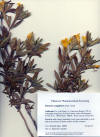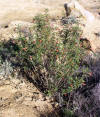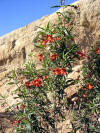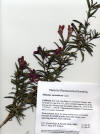| Taxonomic Note (May 2004): Various shrub
types along the Pacific coast from Curry Co. Oregon to Isla Cedros off the
coast of Baja California in Mexico, and also variants that extend inland
along the inner coast ranges of California, and along the Sierra Nevada of
California to the Sierra Juarez of Baja California, are treated in the
Jepson Manual (Hickman 1993) under a single species, Mimulus
aurantiacus. Other authorities have in the past recognized this
obvious polymorphic species to comprise 7–15 species, which have been
segregated into another genus, Diplacus. Flowers vary in
color— from red to yellow—and in size, while the plants also vary in habit
and in pubescence. Although putative hybrids or intermediates
between the various taxonomic entities have been viewed as justification
for treatment under a single species, it is also difficult to ignore
the gross differences that are encountered in the field, especially when
they appear correlated with different ecological environments
Therefore, more than one species in this complex is recognized
below. Differences are based on the keys provided in Abrams (Illus.
Fl. Pac. States, Vol. 3, 1951, Munz & Keck (Calif. Fl.,1959), and
Wiggins (Fl Baja Calif., 1981). The type for M. aurantiacus
was reportedly collected from near San Francisco or Monterrey.
A summary of the taxonomy with references is provided by Montalvo and
McMillan (Oct 2003) under the USDA Forest Service International Programs
website;
http://www.fs.fed.us/global/iitf/pdf/. A poster summary by
Tulig and Clark shows the geographical occurrences of the various taxa and
their intermediates or hybrids,
http://www.csupomona.edu/~jcclark/pdf/p2000aspt.pdf#search=%22Mimulus%20aurantiacus%20taxonomy%22
|
||
|
Mimulus (Diplacus)
aurantiacus
|
Mimulus longiflorus |
Mimulus longiflorus
|

Mimulus (Diplacus) puniceus |
Mimulus (Diplacus)
puniceus
|
Mimulus (Diplacus)
puniceus
|

Mimulus constrictus |
  Mimulus bigelovii |
Mimulus bigelovii
|
|
Mimulus floribundus
|
Mimulus guttatus |
Mimulus guttatus
|
|
Mimulus lewisii |
Mimulus
montioides
|
Mimulus pictus |
|
Mimulus primuloides
|
Mimulus primuloides
|
Mimulus
aff. whitneyi
|
|
Trees and Shrubs of Kern County (Nov 2012) Diplacus. Annuals, perennials or shrubs, ~120 spp. Barker et al. (2012) distinguished Diplacus from Mimulus by the parietal placentation as opposed to axile in the latter, and by the fruit narrowed to apex vs. truncated. Mimulus is now a genus of only two species as a result of their “molecular-phylogenetic and morpho-taxonomic studies.” The rare annual in Kern County, Diplacus pictus, formerly in Sect. Mimulastrum is now placed in Section Eunanus. Key to species of Diplacus
1. Plants erect
stemmed shrubs (30-) 60–120 cm; flowers often red to
1. Plants low rounded
shrubs with wide spreading stems from base, <60 cm;
2. Upper stems with
spider-web hairs; mature calyx tube expanding from a
..... 3. Flowers cream to light yellow, 48–55 mm, the tube not
exerted;
...... 3. Flowers salmon, 40–48 mm, the tube exerted; leaves
hairy but
2. Stems not hairy;
mature calyx tube distally inflated, 3.5–4.0 cm long; Diplacus aridus Abrams 1905 [Mimulus aridus (Abrams) Grant 1925; Mimulus aurantiacus Curtis 1796 var. aridus Thompson 2005]. Southern bush monkey flower. Rounded much-branched shrub, stems numerous, woody, spreading horizontally and then abruptly ascending to 40 cm high; leaves opposite, glutinous, nearly elliptical to widest below the mid region, or wider above mid region, 3–4× longer than wide, 4–6 cm long, uniformly green, margins rolled under and toothed. Flowering Mar–Jul; petals 5, united into a funnel-shape corolla 3.7–5.2 cm long, pale yellow, the main lobes shallowly divided into 2 lobes, with additional small lobes or tears, surrounded by an angular inflated tubular calyx 23–40 mm. Fruit a camarium, opening along the upper suture. Rock outcrops below 4,000 ft, generally southern Peninsular Ranges to central Baja California with a reported disjunct occurrence in Kern Co. Type from Jacumba, CA. Kern Co.: Kelso Creek, between the creek and Kelso Valley Rd, 11 mi south of Hwy 178, R. S. Woglum, 10 Oct 1941, annotated by D. M. Thompson, 1992; however, this specimen was not cited in Thompson (2005), nor did he indicate the species to occur in Kern County. Diplacus aurantiacus (Mimulus aurantiacus Curtis 1796) Jepson 1925. Orange Bush monkey flower. The shrub species of Mimulus in Kern County are generally treated as varieties under this name. Streisfeld and Kohn (2005) found a genetic difference between the red and yellow bush monkey flower species, strictly based on color using a photometer correlated with geography in which they recognized a narrow hybrid zone. Diplacus calycinus Eastwood 1906 [Mimulus longiflorus (Nuttall 1838) Grant ssp. calycinus (Eastwood) Munz 1958; M. longifolius var. calycinus Grant 1925; D. longifolius var. calycinus Jepson 1925; synonym of M. longifolius var. pubescens (Torrey 1857) Thompson 2005]. Yellow bush monkey flower. Rounded subshrub, much-branched near base, stems numerous, spreading horizontally and then abruptly ascending to 50 (-90) cm high; leaves opposite, glutinous, narrowly elliptical, 3–5× longer than wide, 4–8 cm long, upper surface shiny green with impressed pinnate and cross veins, lower surface pale green with glandular hairs and prominent raised mid vein, margins revolute (curled down) and toothed. Flowers Mar–Jul; petals 5, united into a funnel-shape corolla 5.5–6.5 cm long, pale yellow, the main lobes shallowly divided into 2 lobes, with additional small lobes or tears, surrounded by a ribbed and expanded tubular calyx 25–45 mm. Fruit a camarium, opening along upper suture. Rock outcrops below 8,000 ft, oak pine woodland, mixed evergreen forest; central and southern California, Inner Coast Ranges, Sierra Nevada, Temblor Range, San Gabriel and San Bernardino Mts. Type from Tulare Co.: South Fork Kaweah River, 6000 ft,. Kern Co.: Common in Kern Canyon to the desert edge, and in the Temblor Range and Tehachapi Mts., 304–1,462 m. Twisselmann recognized Diplacus as a distinct genus from Mimulus, which was contrary to his following Munz. The shrubby monkey flower species had been treated in a separate genus by Jepson (1925) and by McMinn (1939) who considered D. calycinus as a variety of D. longifolius, distinguished by the sticky arachnoid hairy pedicels, and foliaceous calyx teeth.
|
||
|
Pharmaceutical
references Phillips W. R, N. J. Baj, A. A. Gunatilaka and D. G. Kingston. 1996. C-geranyl compounds from Mimulus clevelandii. J. Nat. Prod. 59: 495–497. "Fractionation of the MeCOEt extract of Mimulus clevelandii yielded the novel 4-geranyl-5-hydroxy-2(3H)-benzofuranone (1) and the five known 6-geranylflavanones diplacone (2a), 3‘-O-methyldiplacone (2b), diplacol (2c), mimulone (2d), and 3‘-O-methyldiplacol (2e). 2D-NMR methods required revision of assignments for diplacone and diplacol and resolved the uncertainty in the site of methylation for the methyl ethers." Salem, M. M., J. Capers; S. Rito; K. A Werbovetz. 2011. Antiparasitic activity of C-geranyl flavonoids from Mimulus bigelovii. Phytotherapy Research 25:1246–49. “Bioactivity-directed fractionation of the MeOH fraction of the extract of Mimulus bigelovii by means of an axenic Leishmania amastigote assay and chromatographic techniques resulted in the isolation of four C-geranyl flavanones, diplacone (1), 3'-O-methyldiplacone (2), 4'-O-methyldiplacone (3), 3'-O-methyldiplacol (4), together with a geranylated flavone, cannflavin A (5). These compounds were separated from M. bigelovii for the first time. All compounds showed moderate antileishmanial activity against axenic Leishmania donovani amastigotes with IC(50) values ranging from 4.8 to 14.6 μg/mL. The compounds were also tested against the related kinetoplastid parasite Trypanosoma brucei brucei and they showed activity with IC(50) values ranging from 1.4 to 7.2 μg/mL.”
|
||


















